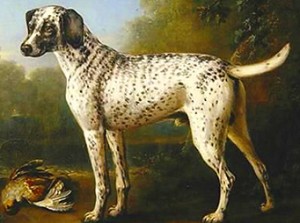In the Eyes of the Artist – The Dalmatian
274 – October, 2017
Text and illustrations by Ria Hör??r
Dalmatian – Dalmatinsky Pas
The Dalmatian’s work was guarding stables and accompanying horse-drawn equipages, but the breed was also used as a hunting dog.
Dalmatica
 Looking at a dog breed in old and new depictions is more or less the same as skating. Just as you think it’s going well, the ice is not yet thick enough and you end up in cold water. Then the handsome black-and-white-spotted dog is not a Dalmatian but a Great Dane. Just because the unusual coat has the uniquely recognizable spots, you were set on the wrong track. Harlequin Great Dane puppies bear an amazing resemblance to Dalmatian puppies.
Looking at a dog breed in old and new depictions is more or less the same as skating. Just as you think it’s going well, the ice is not yet thick enough and you end up in cold water. Then the handsome black-and-white-spotted dog is not a Dalmatian but a Great Dane. Just because the unusual coat has the uniquely recognizable spots, you were set on the wrong track. Harlequin Great Dane puppies bear an amazing resemblance to Dalmatian puppies.
A second problem is the artist. Is he or she a talented horse painter who added a spotted dog to fill a gap? Or is the painting a true-to-nature rendering of a famous Dalmatian? It is important to know what other paintings the artist has made. Is he or she a talented animal painter, or a dilettante? Sometimes more than one painter worked on a painting; an authority on dogs or horses, for example, might be invited to finish an animal’s portrait.
Some knowledge of European history is required when writing about dog breeds. After every war the borders changed, especially after the First and Second World Wars. Before the Cold War, Yugoslavia was the Dalmatian’s country of origin. During the Balkan Wars (1991-95) Croatia became an independent republic (1991) and is now the country of origin. Turks, Romans, Italians, Austrians and Serbs left a mark on Croatia – as well as its dog world.
The name of the breed seems to be derived from the dalmatica, a liturgical tunic dating from antiquity. Dalmatia, once part of Yugoslavia, is now a region in Croatia. The FCI breed standard says: “Dalmatians can be found on the altar painting ‘Madonna with Jesus and Angels’ in the church ‘Gospa od andjela’ in the town Veli Losinj, island Losinj in Croatia dating back to 1600-1630 and also in a fresco in Zaostrog, Dalmatia, Croatia. It suggests that the Dalmatian originates from the eastern Mediterranean region, in particular the historic province Dalmatia.” It is possible that both explanations of the breed’s name are correct. There is, after all, a connection between liturgical tunics and churches!
Breed Standard
After the 18th century, the Dalmatian was developed mainly in England; the first breed standard was written in 1882. The Dalmatian’s work was guarding stables and accompanying horse-drawn equipages, but the breed was also used as a hunting dog. Today it is mainly a com- panion dog.
Some artists painted exactly what they saw; others depicted their patron’s dog not as it was, but as its owner wanted it to look. Some elaborated on older depictions or copied shamelessly. Not every painter knew the anatomy of dogs.
By the end of the 19th century, almost every dog breed had a standard; from then on, the development of a breed could negatively affect its welfare.
Click here to read the complete article274 – October, 2017
Short URL: https://caninechronicle.com/?p=133753
Comments are closed











